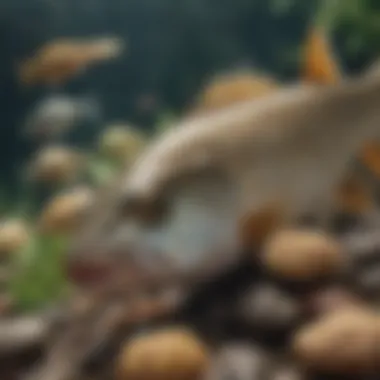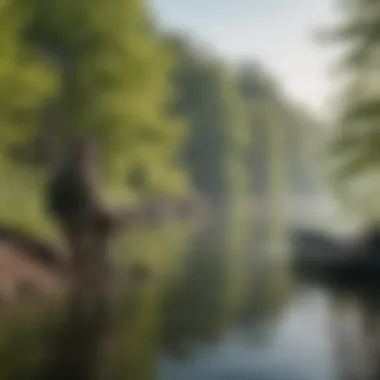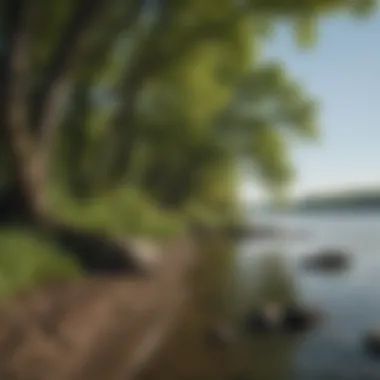Discovering Spring Fishing on Lake Erie: A Complete Guide


Overview of the Topic
Spring fishing on Lake Erie brings forth an enticing array of opportunities for fishing enthusiasts and environmental advocates alike. The щearly months of the year signal a transformative period for theaquatic ecosystem, as temperatures rise and fish migrate to shallower waters. Strategically understanding the environmental nuances during this time is crucial. Anglers find themselves facing a diverse array of species, including steelhead trout, perch, and walleye, which showcase the genetic richness of the lake. This region is significant not only for sport but also for its role as a repository of biodiversity, contributing considerably to the state’s economy and culture.
Lake Erie is the fourth largest of the Great Lakes by surface area, also regarded as the shallowest, which creates different environmental challenges and benefits compared to its deeper counterparts. The rich nutrient waters of Lake Erie foster a unique ecosystem that supports various linda of fish and other wildlife. However, with these opportunities come responsibility. Understanding the ecological dynamics at play is essential in promoting similar sustainable fishing practices, ensuring the health of the environment for future generations.
This exploration encapsulates not only the fascinating world of fishing but also highlights pressing environmental concerns regarding fish populations, habitats, and human activities that threaten the integrity of this precious natural resource.
Current Status and Challenges
Currently, the status of fishing in Lake Erie is shaped by various factors, including climate change, pollution, invasive species, and overfishing. Collection efforts focusing on fish catches indicate that some fish populations are not recovering as expected despite conservation efforts. Intense agricultural practices lead to runoffs that compromise water quality, thus impacting fish behavior and location.
The pressures of climate change, such as rising water temperatures or fluctuating weather patterns, definitely affect many species' spawning habits. Invasive species further complicate these dynamics, as they outcompete native fish and disrupt the food web.
Interestingly, understanding the balance between fishing quotas and conservation is vital. Striking the right balance would address overfishing while ensuring the health of local economies dependent on sustainable practices.
Sustainable Solutions
Promoting 👉 sustainable fishing methods and habitat preservation practices is crucial to address these challenges. Education programs focusing on various fish species' habitats can cultivate responsible fishing behaviors among anglers and trigger a boost in conservation initiatives.
Employing fishing techniques like catch and release in targeted areas can lead toward effective conservation outcomes. Organizations have risen to the challenge, offering programs that blend sustainable practice workshops with practical examples of effective resource management. For instance, The Ohio Department of Natural Resources has collaborated on projects aimed at restocking fish populations and prioritizing water quality restoration.
The community is also instrumental. Successful case studies demonstrate how collective efforts have raised awareness regarding aquatic ecosystems. Involvement in local conversations, restoration projects, or monitoring local water spots makes the community a key player in sustainability efforts.
Impact and Importance
The ongoing efforts surrounding sustainable fishing and environmental awareness significantly impact the broader ecosystem. Maintaining the health of the fish populations directly correlates with regional biodiversity retention. Over time, establishing responsible recreational fishing practices contributes to estate-wide ecological data essential for evaluating environmental changes.
Overarchingly, improving fishing sustainability ensures a healthier Lake Erie for fish, wildlife, and human communities. Conservationеніst challenges not just foster healthy ecosystems but also highlight the need for conservation knowledgeable about the interplay between species and habitat protection. Future generations depend explicitly on today’s conservation efforts toward understanding and engaging with natural resources respectfully and knowingly.
Concluding, participating in the communal responsibility of conservation-focused fishing habits instills a culture of environmental stewardship, making it posible for stakeholders to advocate truly for the lake's protection now and in the future.
Understanding the healthy interaction between fish populations and their habitats is key to successful sustainable practices.
Preamble to Spring Fishing on Lake Erie
Spring fishing on Lake Erie presents a unique opportunity for both recreational angers and professional fishers. The season is marked by fluctuating ecological dynamics which significantly influence angler activity and fish behavior. As water temperatures rise, fish resume their feeding patterns, making spring as an active period for many key species.
This section discusses not only the various eligibilities and benefits associated with spring fishing but also the emphasis on conservation. A deeper understanding of Lake Erie’s geographical and ecological landscape shapes the spring fishing experience. Awareness of the local environment aids fishers in making informed decisions, promoting sustainability while enjoying the sport they love.
Geographical and Ecological Overview
Lake Erie is located in the Great Lakes region of North America. This lake has a relatively shallow depth compared to its larger counterparts. Its aquatic life thrives due to the mix of various habitats such as marshes, reefs, and open waters.
Continuous springtime extractions and ecological shifts play crucial roles here. Nutrient loading changes the food web, establishing a strong connection among and within different fish species. Geographical positioning shapes the varied microclimates influencing water temperatures, oxygen levels, and light penetration.
These factors affect not only the physiologic behaviors of fish but also the timing and quality of fishing in the spring. As temperatures dip and swing again, the average depth sleepers remain crucial; depth changes initiate spawning routines in Walleye and other species.
Significance of Lake Erie in North American Fishing
Lake Erie remains a critical resource for fishing in the United States. It contributes significantly to the recreational fishing economy and is known for its plentiful aquatic species. The lake supports a diverse ecosystem benefiting anglers of all kinds.
Key aspects of Lake Erie's significance include:


- Diverse Fish Species: The lake holds key species like Walleye, Bass, Trout, and Perch, encouraging varied fishing tactics.
- Economic Contributions: Recreational fishing enhances regional economies through developments in tourism and hospitality.
- Cultural Value: Additionally, the lake isn't just a fishing ground; it exemplifies a rich cultural ancestry, bonding local communities with generations of fishing traditions.
Finding the right balance in fishing practices preserves both the enjoyment of anglers and the health of Lake Erie’s ecosystem.
Seasonal Changes Affecting Fishing
Seasonal changes have profound effects on fish behavior and fishing opportunities. Understanding these fluctuations provides critical insights that both amateur and experienced fishers can utilize to enhance their chances for a successful outing. Various factors such as temperature, water clarity, and weather patterns interconnect to inform fishing strategies during spring. Recognizing how seasonal shifts affect the aquatic environment also aids conservation efforts for maintaining healthy ecosystems.
Temperature Fluctuations and Their Impact
Temperature can dictate fish activity and feeding habits significantly. As water warms in spring, fish metabolism increases. This can lead to more active behavior, making it essential for anglers to adjust their approaches. For instance, at around 55 to 65 degrees Fahrenheit, walleye become more territorial and are often observed near shallower waters, particularly during the pre-spawning period.
- Raising water temperatures also impact oxygen levels. Fish require adequate oxygen, which often depletes in warmer water. Spring nights may available cooler temperatures that draw fish shallower; thus, night fishing can be advantageous.
- Pay attention to temperature gradients, as these can provide areas of concentration for various fish species. Looking for abrupt temperature changes can yield fruitful results, especially when fishing around structures or drop-offs.
Water Clarity and Its Importance
Water clarity is another vital factor that significantly influences fish behavior and angler success. Spring runoff and rain can lead to fluctuating levels of turbidity. Clear water generally means greater visibility, causing fish to be more cautious towards baits and lures. Conversely, stained or murky water can allow for stealthier approaches.
Assessing water clarity entails:
- Visual Factors: An experienced angler can decipher clarity while observing light penetration into the water column. Knowledge of how far sunlight reaches can dictate bait choices.
- Edging Near Structures: Fish often tend to congregate in areas where light filters through vegetation.
- Efficient use of strike indicators will allow anglers to gauge reaction times based on water clarity and adjust techniques accordingly.
Weather Patterns and Fish Behavior
Changeable weather patterns in spring have important implications on fishing success. Fish are sensitive to atmospheric changes — fluctuations in barometric pressure can affect their feeding behavior. Autumn-like weather typically means heavy activity for fish, while stable conditions lead to slower responses.
Accurate forecasts can help:
- Fishermen should aim for post-storm events when fish show a heightened appetite due to improved visibility and lower pressure.
- Snap decisions such as adjusting byte and retrieval speed can glean better results in varied weather; adapting is essential to conquer nature. Ideally, always have an awareness of local condition changes that can further your ingenuity.
Always remember that nature dictates the rules, and finding harmony within it can benefit both the ecosystem and the angler.
Key Fish Species in Spring
Understanding the key fish species that inhabit Lake Erie in spring is crucial for anglers and conservationists alike. This knowledge enables targeted fishing practices that align with seasonal trends, increasing the chances of a successful outing. Moreover, knowing about the species helps in supporting sustainable fishing practices which are critical to maintaining the health of aquatic ecosystems.
Walleye: The Spring Favorite
Walleye is one of the prime targets for fishermen during spring on Lake Erie. They are typically spawning during early spring as the water temperature begins to rise. Their preference for deeper waters ensures they gather in specific locations, making them more accessible for traditional fishing methods.
The strategy for catching walleyes often involves using jigs or employing live bait like shiners. The excitement of landing a walleye is heightened by their reputation for being powerful fighters. Those targeting walleye should consider fishing near the warm water outlets and mid-lake structures where they tend to feed actively.
Bass and Their Varied Habitats
Bass fishing in Lake Erie offers a diverse experience, as there are several species to consider, primarily Largemouth and Smallmouth bass. Each species favors different environments, which adds layers of complexity to fishing techniques. Largemouth bass often congregates around submerged structures, vegetation, and shallow waters during springtime while Smallmouth bass school around rocky areas and clear waters.
To effectively fish for bass, anglers might use plastic worms, crankbaits, or topwater lures. Understanding the specific habitat of either bass species helps in choosing the right bait and adjusting techniques. Their varied habitats suggest adaptability in strategies depending on preferred locations.
Perch and Their Seasonal Movements
Yellow perch are integral to spring fishing on Lake Erie, usually appearing in large schools. They typically spawn in shallow waters, making them a prime target for early-season anglers. Their migration habits affect fishing techniques to employ. During spring, cucumber beds and rocky substrate are optimal habitats to look for these fish.
To catch perch effectively, small jigs tipped with minnows can yield promising results. The enjoyment of catching perch lies in the ease with which they can be found, making leasing strategies accessible even for less experienced fisherpeople.


Trout: Strategies for Spring Success
Trout, particularly Rainbow trout, are a valued spring fishing target within Lake Erie. Early spring, immediately after ice out, is the prime time to target these species. Anglers can effectively use fishing gear designed for site-specific approaches. Trout might inhabit colder, deeper waters and can often be found near the streams flowing into the lake.
A good strategy for trout fishing includes trolling with spoons or using live bait such as minnows. Identifying the specific patterns of trout movement around different water temperatures will also enhance the chances of catching them.
By understanding these four key species - Walleye, Bass, Perch, and Trout - fishermen can navigate the waters of Lake Erie strategically, while also being large we responsible in their practices, ensuring these species thrive for future generations.
Fishing Techniques for Spring Success
The techniques employed during spring fishing play a crucial role in defining the overall success of angling ventures on Lake Erie. This section will explore specific elements, benefits, and considerations tied to understanding and implementing effective fishing techniques as environmental conditions shift during spring.
Bait Choices for Effective Fishing
When fishing in spring, choosing the right bait becomes paramount. Various fish species on Lake Erie have different feeding behaviors, and these can shift as water temperatures rise. Common options for bait include:
- Live Bait: Minows and worms can attract species like walleye and bass, known for their preference for live food in spring.
- Artificial Lures: Crankbaits, spinners, and soft plastics also prove effective. These lures simulate the appearance and movement of prey in the water.
- Scented Bait: Products infused with fish-attracting scents can entice fish even in murky water conditions, optimizing success rates.
Anglers should match their bait choice to the target species, as well as adapting techniques throughout the day as fish feeding patterns change due to light and temperature.
Essential Gear and Tackle Recommendations
Using the right gear and tackle is imperative for successful fishing. A setup suited for Lake Erie’s diverse environment includes:
- Fishing Rods: Medium to medium-heavy rods, around 6 to 7 feet long, are preferred due to their versatility in handling different species.
- Reels: Spinning reels for live bait use and baitcasting reels for lures should be on the checklist.
- Line: A strong monofilament line of 10-20 lbs test can handle the size of fish commonly found here.
Each piece of gear must be appropriately maintained for optimal performance, ensuring tackle is tangle-free and ready for action.
Understanding Fish Locating Strategies
Interpreting fish behavior is critical for successfully targeting them. There are various strategies that spring anglers utilize, such as:
- Mapping underwater structures: Awareness of drop-offs, weeds, and rocky formations can guide fishermen to likely hotspots.
- Utilizing technology: Fish finders can help detect schools and their activity levels, especially in deeper areas of the lake.
- Observation: Natural signs, like circling birds or surfacing fish, point to active locations.
As fish are often scattered during the early spring about the lake, sharp observational skills and flexibility in strategies enable anglers to adapt the approach for maximized catch results.
The interplay of technique, bait selection and understanding fish movements creates a comprehensive strategy crucial for successful fishing trips on Lake Erie in the spring season.
Environmental Considerations
Understanding environmental considerations is critical for maintaining the health and sustainability of the fishing ecosystem in Lake Erie. These aspects include the impact of fishing practices on fish populations, the importance of regulations designed to protect them, and the adoption of sustainable practices among fishers. As fishers participate in this activity, awareness of these factors ensures not only the continuation of their sport but also the preserving of aquatic resources for future generations.
Impact of Fishing on Ecosystem Health
The health of an ecosystem largely depends on the balance of species and habitats present within it. Fishing, while a cherished pastime and source of food, influences this balance significantly. Overfishing can lead to depletion of specific fish species, regardless of regulations set in place. Fish communities rely on each other for population stability; removing a key species influences others and disrupts the food web.
Ecological studies have identified several factors influenced by fishing:
- Biodiversity Reduction: Overextraction of certain fish species can lead to less diversity, potentially making the ecosystem more prone to disease.
- Habitat Damage: Techniques like bottom trawling can destroy sensitive habitats, adversely affecting not only target species but non-target organisms as well.
Awareness and a commitment to responsible fishing practices can bode well for the ecosystem’s health. By protecting spawning areas and respecting limits, fishers contribute to sustaining population levels and, consequently, ecosystem vitality.
Regulations to Preserve Fish Populations


Lakes like Erie foster valuable fish species but also face pressures from fishing activities. Regulations play a key role in ensuring fish reproduction and population sustainability. Some key regulations include:
- Size Limits: Ensuring that fishers do not catch fish before they have a chance to reproduce.
- Seasonal Closures: Specific periods may be designated to allow species to spawn without the threat of being captured.
- Quota Systems: Regulations often set limits on the quantity of fish that can be taken to prevent stock depletion.
Fishery management organizations work tirelessly to monitor the populations and adapt regulations to changing conditions. Compliance with these regulations by the fishing community is vital to protect the lake's rich aquatic heritage.
Sustainable Practices for Fishers
Engaging in sustainable fishing practices is essential for the continuous enjoyment of fishing on Lake Erie. These practices not only preserve fish populations but also promote overall ecosystem health. Key tactics include:
- Selective Fishing: Using bait and gearing that minimizes non-target species catching.
- Catch and Release: Causing fewer injuries to fish populations enables the fish to survive after being caught, thus contributing back to the population.
- Educating Other Fishers: Sharing knowledge about best practices and thrilling fishing tales can encourage responsible fishing behaviors leading to wider appreciation for sustainability.
A collective move towards sustainable habits among fishers can yield long-term results, benefiting both the fish populations and their habitats. It is not just an individual effort but a communal responsibility that will safeguard the future of fishing at Lake Erie.
Embracing sustainable practices is not merely about regulations; it forms a commitment to protecting the beauty of our aquatic ecosystem for generations to come.
Conservation Efforts on Lake Erie
Conservation is vital for the sustainability and health of Lake Erie’s ecosystem. As spring introduces fishing activities, it becomes increasingly important to protect fish populations and their habitats. The pressure from fishing and other activities can threaten the delicate balance of this aquatic ecosystem. Fishing responsibly and understanding the significance of conservation measures are paramount in ensuring the future viability of various fish species that reside in Lake Erie.
Organizations and Initiatives Championing Change
Several organizations are actively engaged in forward-thinking programs aimed at conserving the ecological resources of Lake Erie. These initiatives emphasize sustainability and habitat protection while promoting educational programs for the local community. Many organizations organize grassroots movements, stakeholder meetings, and efficiency plans to take action on water quality and fishery health.
A few prominent organizations involved include:
- Lake Erie Conservation Foundation, which focuses on habitat restoration and fish population monitoring.
- The Nature Conservancy, whose initiatives prioritize wetland protection and biodiversity.
- The Ohio Department of Natural Resources, responsible for managing fishery regulations and promoting sustainable practices among anglers.
These groups work collaboratively with local communities, governmental bodies, and researchers to implement plans designed to address issues affecting Lake Erie. By sharing knowledge, resources, and courage, they collectively strive to make a meaningful impact.
Community Engagement in Conservation
Engaging local communities in conservation efforts is critical for the sustainability of Lake Erie’s ecosystems. When people understand the significance of protecting their local environment, they are more likely to contribute positively. Education programs focused on conservation create awareness among residents about the challenges facing the lake. This outreach provides skills to fishermen, encouraging them to adopt sustainable practices.
Many community initiatives take form as:
- Workshops teaching locals about responsible fishing techniques, including catch-and-release methods.
- Volunteer programs for habitat restoration, such as planting native plants along shorelines.
- Events aimed to unite the community, fostering ideas towards eco-friendly activities.
In summary, community involvement raises awareness, encourages responsible behavior, and galvanizes public support for policies designed to preserve Lake Erie’s ecological integrity. As a result, these conservation efforts have the potential to significantly benefit both the lake and its residents in the long run.
Finale
The Importance of Responsible Fishing
Responsible fishing is crucial for maintaining the health and sustainability of Lake Erie's aquatic ecosystem. Overfishing and pollution can deplete fish populations and harm native species. Maintaining the balance of this delicate environment is not only vital for the fish themselves but also for the communities that rely on fishing for their livelihoods.
By practicing responsible fishing, anglers can help ensure the longevity of fish species while also protecting their habitats. Key practices include following local regulations, using appropriate catch-and-release methods, and minimizing debris left on fishing sites. Promoting fish population recovery and collaborating with local conservation groups can greatly benefit the ecosystem.
With education and proper habits, fishermen can positively impact Lake Erie’s environment. This collective effort supports biodiversity and fosters a sustainable fishing culture, that all stakeholders can benefit from.
Future Directions for Fishing on Lake Erie
Looking ahead, the future of fishing on Lake Erie depends on several factors. Improved conservation policies and research into invasive species dynamics will be essential. Continued focus on habitat restoration can strengthen fish populations and enhance overall water quality.
Fishermen and conservationists must work closely when making informed decisions that affect fishing legislations and provide valuable insights concerning regional needs.
Moreover, technology plays a significant role in the evolution of fishing practices. Modern tools like smart fish finders and data analytics can help anglers fish more sustainably by locating fish without disrupting their habitats.
In summary, the way forward includes cultivating a co-operative relationship between fishers, scientists, and government entities. Encourgaging initiatives that educate people about sustainable fishing should be prioritized – ensuring future generations can experience the diverse fishing opportunities Lake Erie offers.



